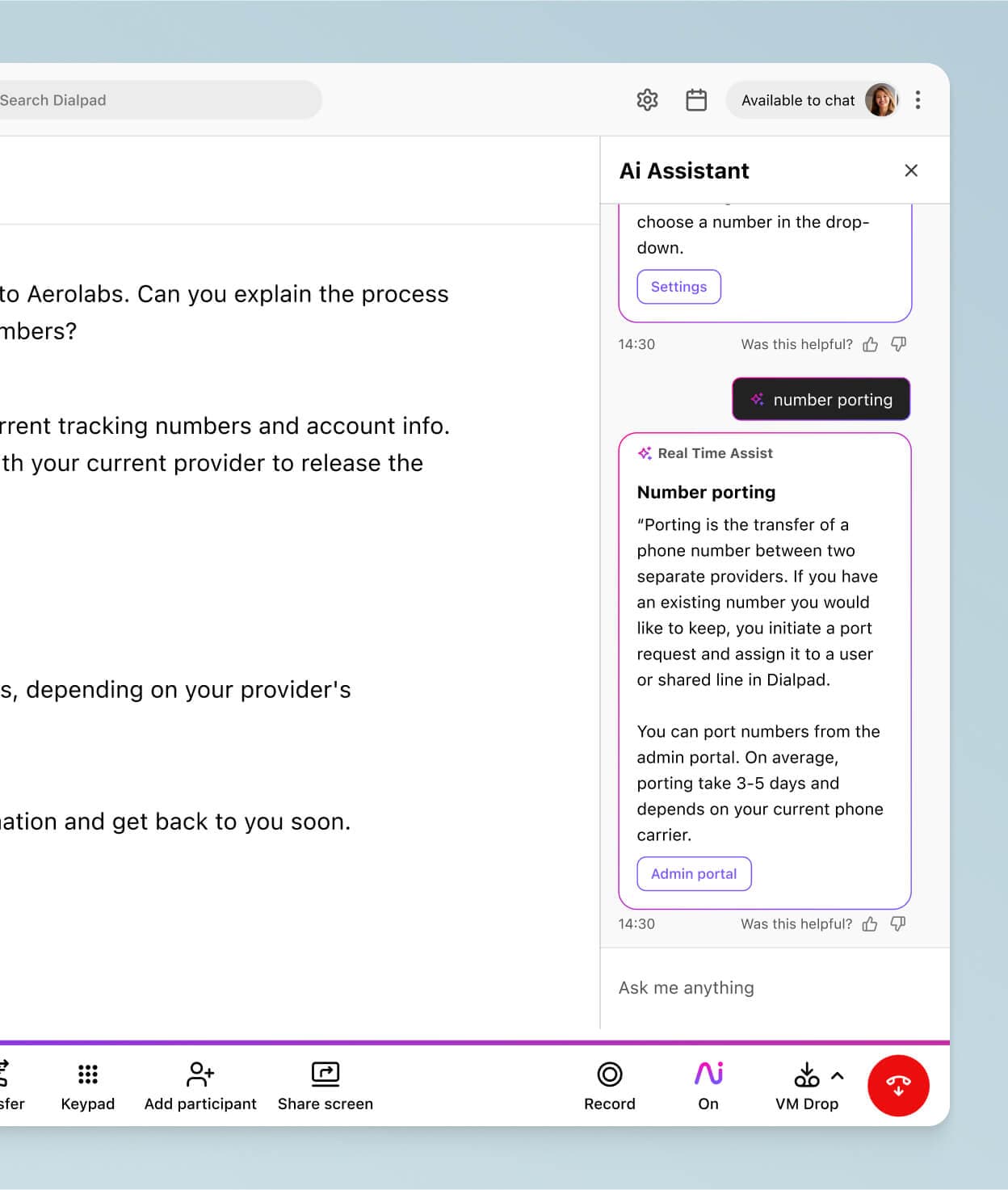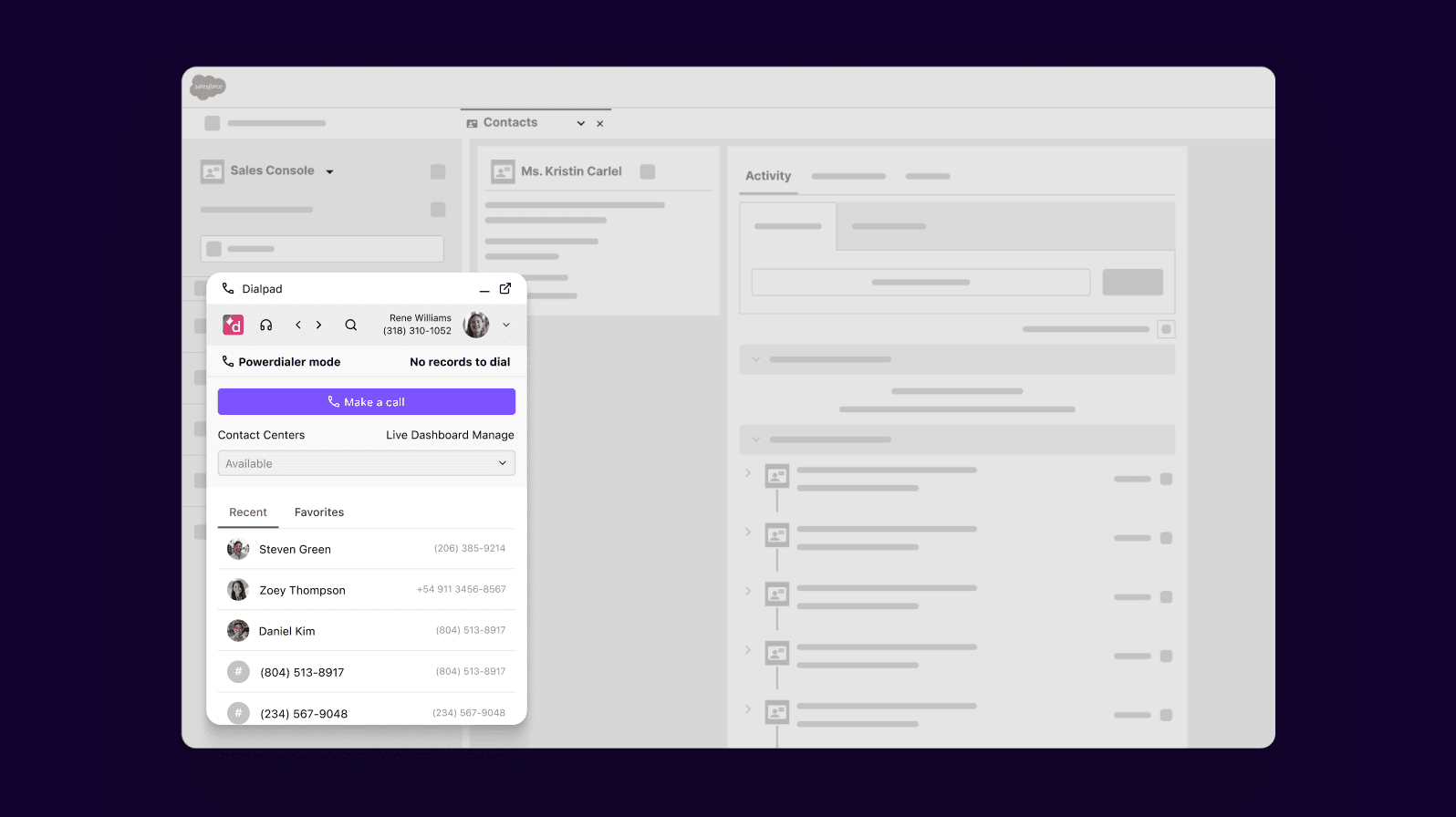Automatic Number Identification (ANI)
Automatic number identification (ANI) is a feature that essentially tells you (or your contact center agents) who is calling you. In this guide, we’ll walk through what ANI is, how it works, and how to use it in your contact center. Or, see how this works in Dialpad's AI-powered customer engagement platform with a product tour.

What is automatic number identification (ANI)?
Automatic Number Identification is a telephony service that was originally developed for billing purposes—specifically, internal long distance toll call charging. (We can thank telephone company AT&T for this invention.) But what does that mean? And what exactly is "internal long distance?"
Essentially, ANI allows the receiver of a phone call to view the phone number an incoming call comes from, without having to manually request that information from a telephone operator.
How it works: The method by which the telephone number of the calling party is transmitted can vary depending on the service provider, however it usually involves some form of digital multi frequency tone being sent through the telecommunications network. This data contains a unique string of numbers, which, when analyzed will reveal the caller’s phone number.
If that sounds similar to what caller IDs do, you’d be correct. Automatic number identification systems do basically the same thing—the only difference is really the technology behind it. This also means that caller ID blocking features have no effect on the transmission of ANI information.
A good phone system or contact center platform (like Dialpad) should automatically identify phone numbers—and if you have a CRM integration, it’ll also be able to match them to the details of customers or prospective leads in your database.
ANI and DNIS
ANI is just one tool that can be used to help identify the details of a phone call. There’s also Dialed Number Identification Service (DNIS), which can tell you information about a caller.
But, unlike ANI, DNIS also gives you details about the specific phone number someone dials in addition to the caller’s telephone number.
This can be useful in situations where businesses may have several different phone numbers advertised, such as a main virtual phone number and a vanity number, which all come through to a single line. For example, a multinational, multilingual business may advertise different phone numbers in different territories.
How is ANI used in a contact center (or business in general)?
ANI can be used by businesses in several different ways. The most obvious way that an ANI service can be useful is to help with call routing since it can help determine the area code or origination of the inbound call (which means you can see which territory, say, a prospect is calling from).
Based on this information, your calls can then be routed using your automatic call distribution (ACD) settings through to the agents responsible for that territory rather than just being distributed randomly. This is also sometimes faster for customers than using interactive voice response (IVR) menus and going through all the branches of a phone tree.
✨ Uplevel your contact center
Grab the Contact Center Playbook, which breaks down everything you need to know, from setup to improving customer satisfaction—with examples from real contact center teams across different industries.
The benefits of ANI for contact centers and call centers
It’s easier to establish good agent-caller rapport
For call center agents and contact center agents, ANI lets them know quickly where a prospect or customer is from, which means they can personalize their customer service better.
Instead of just a, “Hello, who am I speaking with?” a call center agent could see, for example, that a customer is calling from Chicago, and has a long-standing relationship with the company. Their greeting, then, should look quite different—which can help build rapport and make the customer feel less like just a number.
This can be especially important in a sales environment. With a good contact center platform that integrates with your customer relationship management (CRM) software, your sales reps can quickly see if the person they’re calling is a cold lead, or someone in an active deal cycle.
Dialpad Support, for example, integrates with CRMs like Salesforce, HubSpot, and Zoho CRM to not only embed a CTI dialer inside those CRMs (so agents can make phone calls without toggling to a different window), but also automatically log activities:

It allows agents to focus on providing value-adding services
Instead of having to remember to take down customer or prospect, ANI lets contact center and call center agents focus on providing relevant value-adding services since that manual data entry work is done for them.
Another neat thing Dialpad Support can do to empower agents is by popping up Real-Time Assist (RTA) cards on agents’ screens with tailored notes on specific topics—as those keywords are spoken.
For example, at Dialpad we regularly get questions about how we can help customers port phone numbers over. We’re also always hiring, which means we have many new hires and agents who may not be familiar with our porting process.
To help with this, our managers can create an RTA card about our porting process, and set it to pop up automatically on agents’ screens whenever “porting” or “port a number” is spoken on a call:

This way, managers don’t have to personally coach every call, but agents can still get the information they need in real time to provide a good customer experience. It's all built right into the contact center platform—which also lets agents and supervisors make VoIP calls, have video meetings, and send instant + SMS/MMS messaging—all from the same convenient place:

Want to equip your contact center agents with ANI technology?
The good news is you don't have to buy a separate ANI tool or service—Dialpad Support can show caller ID and other caller information, and also integrate with a wide range of CRMs to give agents context on every caller.
You get a versatile, omnichannel contact center solution that lets your contact center manage all internal and external communications from one place (including digital channels like Facebook, Twitter, WhatsApp, and more). Not only is it more cost-effective than having a bloated tech stack, it also makes life easier for your agents and supervisors. See how it works!
Interested in ANI functionality for your contact center?
See how Dialpad Support works with a demo! It comes with Ai-powered real-time coaching, toll-free number support, hold queues, a multi-level auto attendant, and much, much more. Or, take a self-guided interactive tour of the app first!
